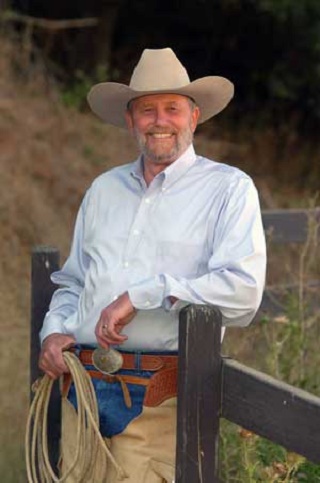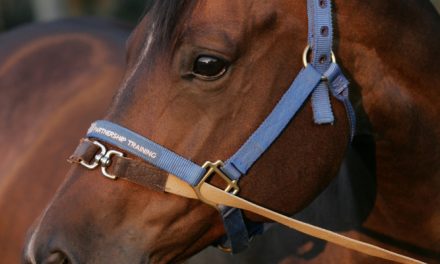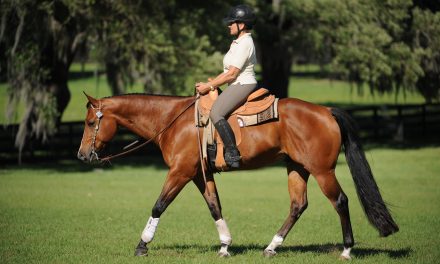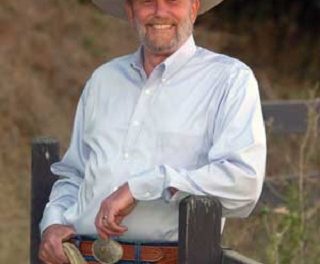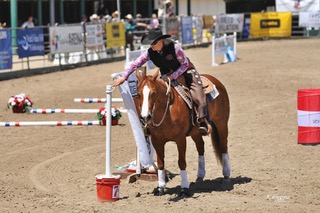 A round pen can be an excellent tool. It creates a very safe training environment with the round edges, smooth sides and no corners. It should have sides at least six feet high so a horse can get his head over the top of it. Some people work in a square pen but you spend a lot of time teaching the horse to stay out of the corners, which is an exercise in itself. I don’t see the benefit and I think it is a little harder on the horse. Also, the diameter plays a role in its usefulness and I personally don’t want anything larger than sixty feet across. Anything larger and you lose a connection with the animal. It can be very hard to keep a horse moving in a larger round pen, particularly if the horse is lethargic and doesn’t want to move. More than sixty feet is harder on the horse and the handler. You don’t want anything smaller than forty feet across but fifty or fifty-five feet can work well. I like the larger sixty-foot size and that is what we have here at the ranch as I occasionally have big warm bloods here. Larger horses move faster and cover too much ground to be worked in a smaller round pen. Also, if a horse is really edgy, has a high flight response or is fearful, a forty or fifty-foot pen is not large enough. I have had horses in our sixty-foot pen that I’m not doing anything with, and I have about the softest posture in the world, but the horse just runs around on its own.
A round pen can be an excellent tool. It creates a very safe training environment with the round edges, smooth sides and no corners. It should have sides at least six feet high so a horse can get his head over the top of it. Some people work in a square pen but you spend a lot of time teaching the horse to stay out of the corners, which is an exercise in itself. I don’t see the benefit and I think it is a little harder on the horse. Also, the diameter plays a role in its usefulness and I personally don’t want anything larger than sixty feet across. Anything larger and you lose a connection with the animal. It can be very hard to keep a horse moving in a larger round pen, particularly if the horse is lethargic and doesn’t want to move. More than sixty feet is harder on the horse and the handler. You don’t want anything smaller than forty feet across but fifty or fifty-five feet can work well. I like the larger sixty-foot size and that is what we have here at the ranch as I occasionally have big warm bloods here. Larger horses move faster and cover too much ground to be worked in a smaller round pen. Also, if a horse is really edgy, has a high flight response or is fearful, a forty or fifty-foot pen is not large enough. I have had horses in our sixty-foot pen that I’m not doing anything with, and I have about the softest posture in the world, but the horse just runs around on its own.
So, how can we utilize this very useful tool, the round pen? It can be used for many different types of exercises and training. I often begin by getting a horse to connect with me, in other words to recognize me as a leader and start following me with his eyes and yielding his hind quarters. I can also work with a horse to start de-spooking exercises. It is a good place to teach a horse to go over a tarp, a pole or other objects. If the horse gets away, he can’t go very far and can’t get caught up in a corner. I use the round pen to teach my horses flexibility. It is also a good place to start the first half dozen or more rides on a horse, depending on the nature of the horse. You can also start teaching a horse to be ridden without a bridle. I have a DVD that covers many, many different effective ways to use a round pen.
Just like any tool, it is how we use that tool. Over many years at the various horse Expos I have coined the phrase, “It is not the equipment that trains the horse.” Now, it is not the equipment and it is not the exercise that trains the horse. There are a lot of great exercises from a lot of nationally known trainers that do quite a good job. You see the magic in an exercise but when you try it, you don’t get the same result. This can happen in a round pen, as well as another environment; it is the way an exercise is done that determines if it is effective.
We do use the flight instinct to get the horse to move around us and away from us. You do not have to run a horse into the ground but you don’t want the horse to walk either. You want good forward movement without the horse looking around or thinking about what is outside. The horse needs to put energy into the gait you ask for. Also, you want the horse to be thinking about you. One of the things we haven’t discussed that is very important is that when you control a horse’s feet, you control the mind. And that is what is neat about a round pen, it is a small, quiet, safe environment and it makes it easier to get control of the feet. When you first start round penning your horse, you want at least a good forward trot, at minimum a good working trot. If the horse gets lazy at that, I will push it to a canter. I want a horse to go forward consistently at any gait at any time and I always want the horse to go forward consistently. When a horse is stopping and thinking about something else, we are not moving the horse enough. We are looking for consistent forward movement, which is controlling the horse’s feet. The idea is to push the horse to start thinking about who we are and that we are a force to be reckoned with. That may sound harsh but it is not when you consider the dynamics of a horse that is out with a herd. Out in pasture, a horse will run another horse around, almost running it into the fence and then will run it back the other way. What that horse is doing is establishing leadership. Leadership is also what we need to establish but that does not give us license to run our horse into the ground. To establish leadership we must get the horse to go forward and to go forward consistently. Then we ask the horse to change directions. In the beginning it does not make any difference if it is an inside or an outside turn, we are simply controlling the horse’s feet.
Once I have a horse going forward consistently in both directions and changing directions, I am controlling the horse’s feet. Some horses will want to stop and change directions on their own. You, as the lead horse, need to send the horse back to moving forward in the direction you have established. Also, there are some horses that will challenge you several times and you must be consistent in your response. Round pen work really establishes the handler as the leader. When a horse is starting to look at me, tipping his nose in and I can see that his inside eye and left ear are on me, I know he is paying attention. When I stop the horse, I like it to turn and face me, giving me both eyes. I do this by stepping away and, in a manner of speaking, drawing the horse toward me by moving away from his shoulders and nose. If the horse is moving along pretty well with a nice brisk forward working trot or canter, you may have to spiral backward quickly as the horse is going to want to catch up with you. This is the first time we are training our horse to do something besides a change of direction. We are asking the horse to turn into us and look at us. I’ve worked with a lot of nervous and skittish horses and it can be done. Some horses just take longer than others. This is raising the standards and being specific with your horse.
It is easy to have a horse change directions, especially when the horse turns to the outside because he doesn’t want to be with you in the first place. And, yes we are motivating the horse using the flight instinct. We are using the herd mentality to control the horse. It only becomes a problem to use the natural instinct when we run a horse into the ground. Sometimes we think we need to run a horse in one direction for a very long time, twenty laps. The most I run a horse in one direction is seven or eight laps. After that the horse is starting to think about me, it is time to step back and ask the horse to come in. If your horse starts to come in, slow down and is turning the head, that is not the time for you to stop. You need to continue spiraling back toward the inside rail of the round pen. Then if the horse stops just except that or take another step backwards and leave the horse alone and let him rest.
This may be the first time that you have really connected with the horse. By working in the round pen properly, you can really gain the horse’s trust. Work in the round pen is also a good gymnastic exercise as we teach the horse inside and outside turns. We can actually do figure eights and teach the horse to do lead changes and flying lead changes. We can teach our horse to do curly cues and use the hind quarters by making an inside turn and then quickly making an outside turn within a six-meter circle. This is a very good gymnastic exercise for a horse.
Look not only at the application of the exercise but at the end result. A horse should be more calm after a lesson. His neck should be down and relaxed; he should be paying more attention to you. If a horse never gets relaxed, the handler asked too much of the horse or never gave the horse an opportunity to relax (too much pressure). You need to give the horse a chance to drop its head, relax and know that it has done the right thing. The round pen is just a tool. It is what we do with it that trains the horse.

